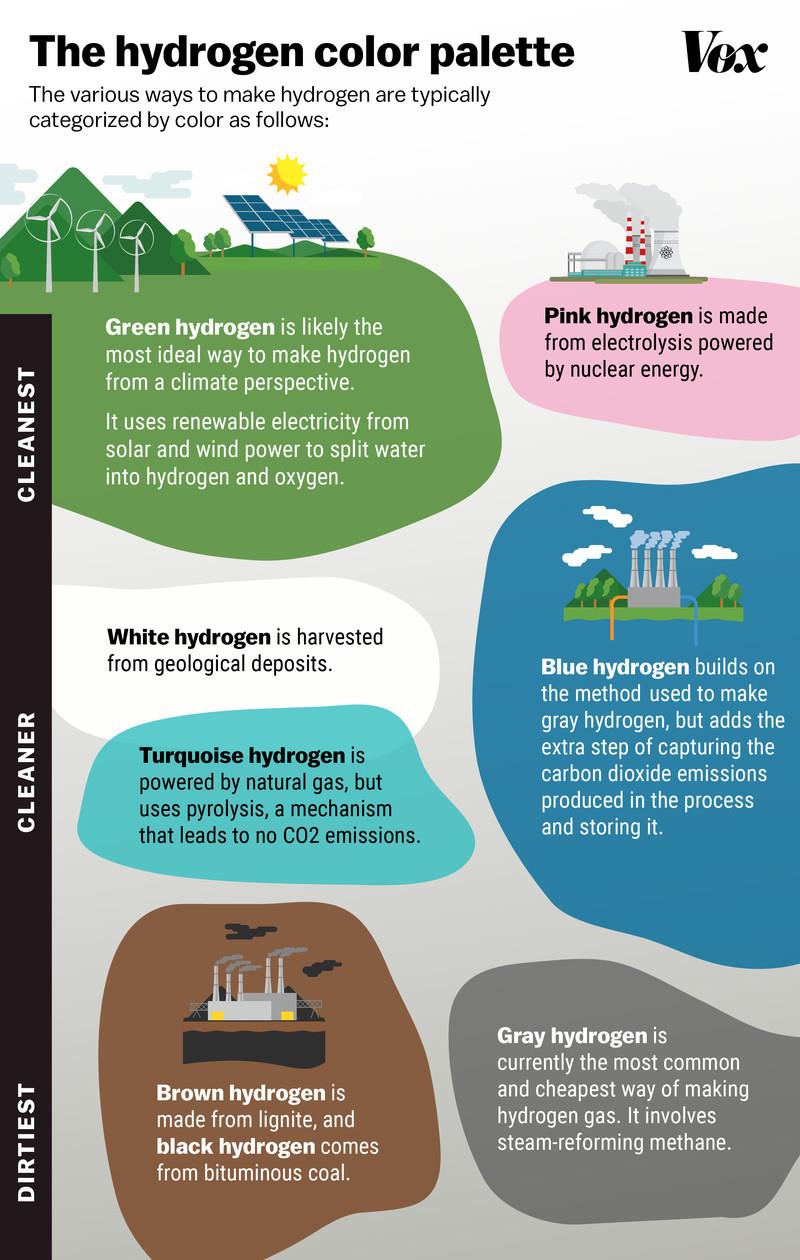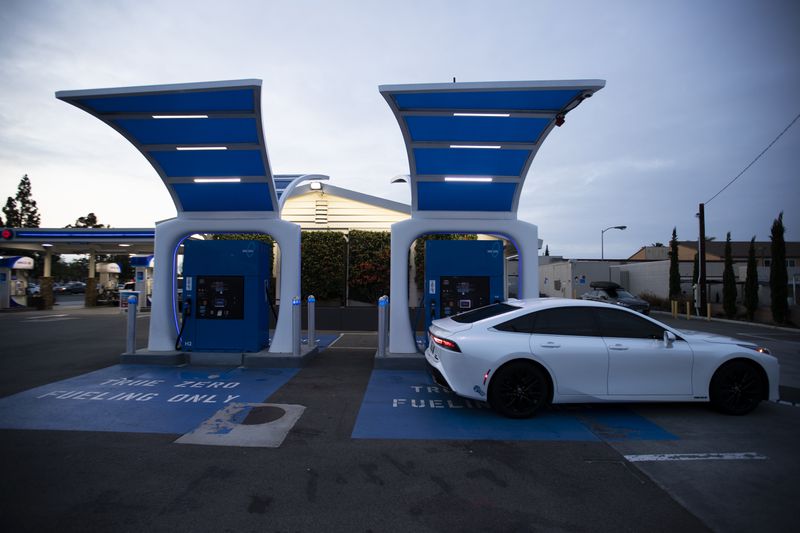
Clean hydrogen can be a lot dirtier than it seems, especially when the fossil fuel industry gets involved.
One of the biggest bets of the Biden administration is that clean hydrogen will help the United States reach its climate goals, revitalize domestic manufacturing, and bolster a shrinking fossil fuel workforce. That’s a lot riding on an industry that barely exists today.
The term “clean hydrogen” can mean many things — some of which aren’t exactly clean. Hydrogen is the most abundant element in the universe, and it’s a very promising energy source that could power sectors of the economy that electrification and renewables currently cannot. But the pure hydrogen gas that works as fuel first needs to be produced, and that process can either be polluting or clean.
The US government is currently determining what counts as clean hydrogen, and the exact terms it agrees upon will have huge implications for what will effectively become an entirely new energy industry. Meanwhile, building the infrastructure to produce it wholly from scratch will be tough to pull off. That’s a problem a new system of so-called hydrogen hubs aims to fix.
President Joe Biden was at the Port of Philadelphia, Pennsylvania, on October 13 to announce the creation of seven new hydrogen hubs around the country that will produce hydrogen fuel and begin to establish this new energy industry. The Biden administration envisions these hubs to be sprawling clusters of pipelines and facilities across hundreds of miles, and the Department of Energy is spending $7 billion to build them.
The federal funding is just a start. The Biden administration hopes these projects attract another $40 billion in private investment. And generous government subsidies earmarked in the Bipartisan Infrastructure Law and the Inflation Reduction Act are aimed at providing the private sector with the incentive to boost not only the production of hydrogen but also the demand for it.
“You get very few chances to set up the political alliances and funding of a new industry,” Craig Segall, vice president of policy at environmental policy group Evergreen, told Vox. “You never get a crack at this. It’s as if we were at the beginning of coal or gas.”
Republican and Democratic politicians alike have dreamed for decades of using the most abundant element in the universe to someday power manufacturing, buildings, and even cars. Hydrogen can be burned just like gasoline in an engine. It can also be used to generate an electrical current. When burned, it produces no carbon emissions and few air pollutants. In a fuel cell, its main byproduct is water.
The problem is how to scale hydrogen without worsening climate pollution or cannibalizing existing clean power on the grid. Virtually all of the hydrogen produced today comes from fossil fuels, and the industry that stands to benefit the most from the government’s massive subsidies is oil and gas.
“Some people have talked about it being the Swiss Army knife for decarbonization, where it could be used for almost any application,” said Dennis Wamsted, an energy analyst with the Institute for Energy Economics and Financial Analysis. “But that doesn’t mean it’s the best tool; it doesn’t mean it would be the best or the cheapest, or the fastest, or the most reliable.”

Evan Vucci/AP
So the Biden administration has an unusual opportunity to set the contours of how clean the hydrogen really becomes. The newly announced hydrogen hubs are just the first step in a multiyear, multibillion-dollar road. The government is essentially propping up a nascent industry, but with that massive support comes an opportunity to set the terms of an industry right. And nobody’s exactly sure how it will all unfold.
“An entire ecosystem like this where you’re coming up with an all-new energy product,” said David Crane, the Department of Energy’s undersecretary for infrastructure, “it probably is unprecedented.”
Clean hydrogen, explained
There’s a way to produce hydrogen that worsens climate change, and there’s a way to do it cleanly. It all depends on how the hydrogen is produced, and currently, almost all of it is made in a way that increases carbon emissions.
The way energy wonks talk about hydrogen is by color — which is funny since hydrogen gas itself is colorless.
Right now, nearly all of the existing hydrogen produced in the US today isn’t clean at all. Ninety-five percent of it is “gray hydrogen,” produced using a method called steam methane reforming. This process uses steam to heat methane derived from natural gas until it separates into a mixture of carbon monoxide, carbon dioxide, and hydrogen gas molecules. This process is incredibly energy-intensive and gives the gray hydrogen production industry a carbon footprint the size of the United Kingdom and Indonesia combined. Gray hydrogen is mostly used for industrial purposes like refining petroleum and metals as well as producing chemicals, fertilizer, and in rarer cases, fuel for vehicles.
Blue hydrogen is a tiny but growing subset of the industry. Similar to gray hydrogen, blue hydrogen production uses steam methane reforming, which means that it also relies on natural gas. But for blue hydrogen, carbon capture and storage and other monitoring attempts are introduced to limit leakage of methane, a powerful greenhouse gas, which in theory minimizes its impact on climate change. And carbon capture and storage technologies haven’t been proven at the scale for blue hydrogen to capture over the 90 percent of emissions needed to deliver climate benefits.
A third and very buzzworthy option is green hydrogen. Producing green hydrogen employs a process called electrolysis, which uses an electrolyte, anode, and cathode to create a chemical reaction that splits water into hydrogen and oxygen molecules. No carbon capture is needed here, as no fossil fuels are involved in the process. As the name implies, this is the cleanest way to produce hydrogen — if it relies entirely on renewables for the electricity to power the process. It is currently very expensive and requires subsidies to compete with dirtier hydrogen options.
One other consideration with these types of hydrogen is the energy needed to produce them. Both blue and green hydrogen could be used in similar ways and work as a clean energy solution, except a lot rides on how the hydrogen is made. If energy derived from fossil fuels powers the production of any type of hydrogen, that could undermine carbon cuts. For green hydrogen, specifically, electrolysis is a problem area because it’s so power-hungry. So it’s essential that the electricity that powers the process comes from renewables, like solar, wind, and nuclear. It also matters where the renewables come from. One worry environmentalists have is that new hydrogen facilities will simply draw from existing solar and wind, eating up a lot of the clean electricity we already have.
“Making sure that this power is squeaky clean is absolutely necessary to make sure we’re not increasing emissions on the grid,” said Rachel Fakhry, NRDC’s emerging technologies director. “Even a little bit of fossil fuels powering the system could drive very high emissions on the grid.”
There are even more colors of hydrogen, each of which refers to a different production method. So while the phrase “clean hydrogen” is thrown around a lot, it’s not always clear what it’s referring to.

Amanda Northrop/Vox
The hydrogen production question is a minefield that the Biden administration ultimately needs to navigate as it props up this burgeoning industry. And in writing the rules for this hydrogen-powered future, the Energy and Treasury Departments are playing unusually important roles.
What’s in the hydrogen hubs announcement
Biden’s recent $7 billion announcement, it deserves to be said, is a major one. It reveals the broad blueprint the Department of Energy intends to follow to build an entire energy industry almost from scratch. The Bipartisan Infrastructure Law gave the department $8 billion to develop both supply and demand for hydrogen — the other $1 billion will be used for supporting demand — and now we know some details about how it will spend the vast majority of that on the projects the DOE has prioritized.
These seven hydrogen hubs are spread across states in the Gulf Coast, Appalachia, the Pacific Northwest, California, the Midwest, and the mid-Atlantic. Picked from a pool of 79 proposals submitted by private-public partnerships to the DOE, the winning proposals are sprawling plans for existing infrastructure as well as wish lists for new buildings and pipelines that ultimately have a long road of permitting and funding ahead.
The specific locations of the hubs are noteworthy not only because of how they will affect communities around them but also because of how the electric grid works in those areas. The hubs aim to draw on a mix of renewables and natural gas infrastructure to develop blue and green hydrogen, but some of the largest projects planned could play out heavily in the fossil fuel industry’s favor.

Allen J. Schaben/Los Angeles Times via Getty Images
According to the White House, two-thirds of the overall funding supports green hydrogen development, but at least two of the hubs will primarily rely on blue hydrogen — which, again, relies on natural gas. The Houston-Gulf Coast hub, the largest of all of the hubs, plans to rely heavily on carbon capture for 2 million of the 3 million tons that come from natural gas — a task that will likely mean remodeling some of the region’s existing facilities with carbon capture equipment and pipelines. Other hubs, like the ones in the Midwest and mid-Atlantic, draw also from existing nuclear power sources.
When fully operational, the White House says the seven hubs would reduce 20 million metric tons of carbon dioxide — the equivalent of 5.5 million gasoline-powered cars.
Not everyone is happy with the Biden administration’s approach to building out the hydrogen industry. Fakhry was among the environmentalists expressing disappointment in the DOE’s process so far, calling the announcement a “mixed bag” with “some potentially promising elements.” She does see the potential for hydrogen cutting emissions in industries that are difficult to switch to renewables, but the continued reliance on fossil fuels is a sticking point.
“I was frankly surprised at the level of dependence on gas-derived hydrogen and on gas-reliant power sources,” Fakhry said.
Again, the exact terms the government is setting for what counts as clean hydrogen is still unclear. Will blue hydrogen facilities have to meet specific carbon-capture standards to be counted as clean? How will natural gas leaks be minimized? From the early details of the hydrogen hubs announcement, it appears the Department of Energy is following an all-of-the-above approach for hydrogen, relying on fossil fuels as well as renewables for future production.
This makes the next move from the Biden administration all the more critical: The Treasury Department is crafting standards that will ultimately set the course for what a hydrogen economy looks like. These decisions will permanently shape an industry that is just starting to find its footing around the world, and may start trading internationally as early as the 2030s.
Why the next move from the Treasury Department matters even more for hydrogen
The fate of Biden’s big plans lies in the hands of an unexpected government agency: the Internal Revenue Services. Soon, the IRS will find itself in the unusual situation of developing policy that will ultimately govern how the hydrogen energy industry operates. It could, in turn, determine how much pollution this industry produces.
Sometime before the end of the year, the Internal Revenue Service is supposed to release guidance for a hydrogen production tax credit, called 45V. These are generous tax credits meant to attract more investors to hydrogen. The Inflation Reduction Act only vaguely defines the tax credits as applying to “clean hydrogen,” leaving it to the IRS to decide how to set the terms for what can be eligible for potentially $100 billion over the lifetime of the credits.
So the Biden administration is now in the process of defining how broad or narrow the tax credits will be for defining what counts as clean hydrogen amid all its caveats. If the standards are too stringent, hydrogen may never get off the ground. But if they’re too lax, there’s a risk the industry could become another carbon bomb — or even just an extension of the fossil fuel industry.
Clean energy industry leaders and environmentalists have thoughts on this. One of the key proposals they’re making is a strict definition based on three pillars.
The core pillar is known as additionality, which would require hydrogen producers to add new renewables to the grid instead of diverting existing nuclear, hydro, wind, and solar. Tapping new renewables avoids a problem environmentalists are especially worried about: that diverting existing electrons on the grid to produce hydrogen diverts from other climate goals to clean up pollution from buildings and transportation.
The second and third pillars are called deliverability and hourly matching. These hold producers to similarly strict measures so the hydrogen industry isn’t taking away from clean energy already out there. They require producers to source clean energy near where it’s consumed and match that energy hourly so they can’t run on credits for, say, solar when the sun is down.

Evan Vucci/AP
These ideas are divisive. You may have seen the ads coming from trade groups supported by ExxonMobil and utilities fighting back against additionality. And Jacob Susman, CEO of hydrogen company Ambient Fuels, also argues for annual matching instead of hourly, saying it is a less stringent standard that allows the industry to use renewable energy credits.
“We need to be flexible in approaches early on so that we can get the cost down,” Susman told Vox. “It would be very reasonable in a few year’s time to start talking about tightening the way it’s defined.”
The stakes here are incredibly high. The way the hydrogen industry takes shape will determine whether it ensures greenhouse gasses actually fall as the White House hopes. And taxpayers are footing the bill for potentially over $100 billion in incentives that could boost the fossil fuel industry if not done right.
And production is hardly the only challenge ahead. Most of these policies just tackle the supply side of hydrogen, not addressing who and how it will be used to lower emissions. The $1 billion the DOE has reserved to build up demand will go toward projects that slash emissions in tricky sectors like manufacturing cement and aviation fuels. It also is likely to be used in the power sector, as the Environmental Protection Agency’s new rules for cleaning up climate pollution assume gas plants could use a blend of hydrogen to meet stricter emissions standards.
The Biden administration ultimately considers hydrogen key to reducing 25 percent of global climate emissions by 2050. That is, in part, because there are simply parts of the economy that can’t be cleaned up by relying on renewables and electrification alone. We’re not going to see the biggest gains with hydrogen-powered SUVs but rather hydrogen-powered container ships and planes.
“Heavy transportation and heavy industry are the toughest nuts to crack, said Crane from the DOE. “And hydrogen is the solution to that.”
----------------------------------------
By: Rebecca Leber
Title: Why Biden’s multibillion-dollar bet on hydrogen energy is such a big deal
Sourced From: www.vox.com/climate/23900109/hydrogen-green-energy-hubs-biden
Published Date: Mon, 16 Oct 2023 19:50:00 +0000
Did you miss our previous article...
https://consumernewsnetwork.com/politics-us/what-can-the-history-of-modern-war-offer-prime-minister-netanyahu






